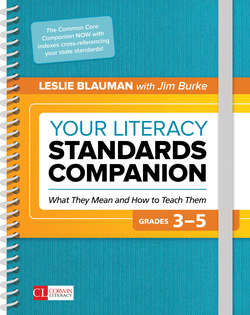Читать книгу Your Literacy Standards Companion, Grades 3-5 - Leslie Blauman - Страница 23
На сайте Литреса книга снята с продажи.
Common Core Reading Standard 1: What the Teacher Does
ОглавлениеTo teach students how to “read closely”:
Think aloud your close reading process as you share fiction and informational short texts and picture books. When reading shared novels as a class, plan ahead a chapter opening or passage you want to model with. Track thinking with sticky notes placed directly on the text, big chart paper and/or highlighting, displaying text on a screen.
Pose questions about the text’s words, actions, and details that require students to look closely. Don’t do the answering for them!
Display a text via tablet or computer and ask students to select specific words, sentences, or paragraphs they think are essential; ask students to explain how it contributes to the meaning of the larger text.
Draw students’ attention to text features and structures, and think aloud how you combine information in these elements to understand the page/section/text as a whole.
Provide short pieces of text for students to practice “reading closely” for specific purposes.
Have students respond to their reading and their thinking about texts. This could be accomplished in response journals or other reading notebooks.
To teach students how to ask and answer questions to demonstrate understanding:
Using picture books, ask a question and think aloud how it helped you understand. For example, when a fiction reader muses, “I wonder why she acted that way towards him?” it puts the reader on high alert, looking for the answer in the text. Readers of nonfiction also pose questions when their comprehension falters or as a way to cement understandings, sentence by sentence. For example, “What does hibernation mean? I sort of think it has something to do with winter, but I’ll read on to see if the author explains it.”
Use chart paper to record students’ questions about a shared text as you read. Then, after reading, go back and answer these questions. Encourage students to pose analytical (how, why) questions along with literal (who, what, where, when) questions. Code if questions were answered literally (L), inferentially (I), or not answered at all (NA).
Over time, help students grasp that readers pose questions before reading (What’s my purpose for reading this?), during reading (What’s with all the descriptions of sunlight in each chapter?), and after reading (What did the main character finally learn?).
Have students practice posing questions on their own (independently). Students can annotate on the text where they have questions. Have students share them with a partner or the class.
To develop students’ ability to determine “what the text says explicitly, “refer to details and examples in a text,” and “quote accurately from a text”:
In a series of lessons and using various texts, write text-dependent questions on sticky notes or annotate in the margins. Model how to find the answers to the questions posed. Annotate in the margins the exact words where questions are answered.
Provide students with a copy of a sample text and circulate, coaching as they highlight specific details and annotate their thinking. Remind them to “say what it says”—not what they think it means.
Photocopy and distribute short pieces of text and highlighter markers, and instruct students to highlight sections of the text to show where questions you pose are answered explicitly (or literally). Compare findings as a class.
Using whiteboards, have students highlight quotes from a text to use as evidence when explaining what the text is about.
Provide graphic organizers for students to write their questions and then record details, examples, and quotes.
To teach students how to “draw inferences from the text”:
Choose texts to read aloud and plan where you will model inferring. Think aloud how you make inferences, and tie these inferences back to specific words and phrases in the text.
Have students use two different colored highlighters to code where information in the text is answered literally or explicitly and another color to show where it’s answered inferentially. Annotate how the text led to inferences.
To help your English language learners, try this:
Confer with students and have them read aloud a portion of the text. Then stop and have them tell you what questions they have about what they’ve read.
For graphic organizer templates, see online resources at resources.corwin.com/literacycompanion3-5.
